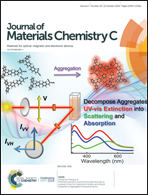Predicted polymorph manipulation in an exotic double perovskite oxide†
Abstract
Predicted polymorph manipulation offers a cutting-edge route to design function-oriented materials in an exotic double perovskite-related oxide A2BB′O6 with small A-site cations. Herein, first-principles density functional theory calculations in light of the equation of state for solid, for the first time, was used to predict the Mg3TeO6 (R![[3 with combining macron]](https://www.rsc.org/images/entities/char_0033_0304.gif) )-to-perovskite (P21/n) type phase transition in Mn3TeO6 at around 5 GPa, regardless of the deployment of magnetic interactions. The high-pressure synthesis and synchrotron diffraction crystal structure analysis corroborated experimentally the polymorph variation in Mn22+Mn2+Te6+O6, which was accompanied by a 13 K increase in the antiferromagnetic ordering temperature (37 K) in the high-pressure perovskite polymorph compared to that of the ambient-pressure R
)-to-perovskite (P21/n) type phase transition in Mn3TeO6 at around 5 GPa, regardless of the deployment of magnetic interactions. The high-pressure synthesis and synchrotron diffraction crystal structure analysis corroborated experimentally the polymorph variation in Mn22+Mn2+Te6+O6, which was accompanied by a 13 K increase in the antiferromagnetic ordering temperature (37 K) in the high-pressure perovskite polymorph compared to that of the ambient-pressure R![[3 with combining macron]](https://www.rsc.org/images/entities/char_0033_0304.gif) phase (24 K). The magnetodielectric coupling remains up to 50 K with the maximum being around the magnetic ordering temperature in the perovskite Mn3TeO6. Thus, the predicted polymorph manipulation here offers the possibility of discovering accelerated materials by inverse design in exotic perovskite oxides.
phase (24 K). The magnetodielectric coupling remains up to 50 K with the maximum being around the magnetic ordering temperature in the perovskite Mn3TeO6. Thus, the predicted polymorph manipulation here offers the possibility of discovering accelerated materials by inverse design in exotic perovskite oxides.



 Please wait while we load your content...
Please wait while we load your content...
